Note: If an image ever fails to appear - refresh your page, it really is there
Flags of the American Revolution Era
| Top of Page | Flags before 1776 | Flags after 1776 | Unit Standards and Colors | War of 1812 |
Revolutionary Regimental/Division/Unit Standards and Colors
There were hundreds of unit flags used on both sides of the American Revolution. They were all hand made and unique in design, and most of these originals didn't survive and were lost so that today only about 30 still remain. For those that survived, we can be fairly certain of their appearance. For those lost or partly destroyed we only have written descriptions to try and reproduce them, and because of this these modern reproductions are all open to interpretation and questionable.
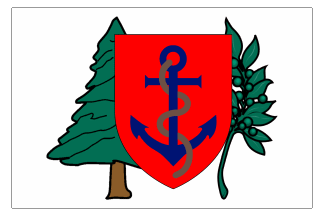
Speculative NIMC Flag
|
Newburyport Independent Marine Company Flag pre-1774
Among the independent militia companies formed prior to 1774 was that of the Marine Society of Newburyport. At a meeting in the Wolfe Tavern in Newburyport the Independent Marine Company was formed under the command of Captain James Hudson, who operated an important salt works in Massachusetts. It is claimed to be the first militia company of seamen mustered to defend American rights in the revolution. The Newburyport Independent Marine Company had about 76 members. Their colors combined the insignia of the State, a standard of a blue anchor on a red field, supported by a pine tree and olive branch. This speculative image is the work of vexillologist Dave Pawson.
According to research done by Pawson all the company's officers were actual sea captains and several of them commanded vessels during the Revolution. All the seamen, except for Hudson, were also part of the Newburyport Artillery unit that participated in the Rhode Island campaign in 1777. Some also most likely participated in the Independent Company of Newburyport which was organized to protect the Massachusetts coastline. |
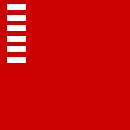
Manchester Militia Flag
|
The Forster Flag pre-1775
The legend behind this interesting flag is that it was a British Regimental color captured on the first day of the American Revolution. Since there were no British Colors reported lost that day, and none of the regiments present carried any similar colors, the whole story is untrue. In fact, it is now believed this flag was actually a loyal militia flag. Major Samuel Forster, a Massachusetts officer, apparently acquired the flag sometimes during the war, and after his death, when his family discovered it among his belongings, they believed it to be a captured British flag.
Recent research, however, indicates that this flag was the original colors of the Manchester Company, First Essex County Militia Regiment, Massachusetts Bay Colony. Samuel Forster, as a Lieutenant, was a member of the Essex Regiment sent to the aid of Lexington and Concord, so the flag probably was at the battle, but certainly not on the British side. It actually pre-dates the Revolutionary War. The white stripes are sewn onto each side separately and the red in between is the base field of the color, so legends about the King's colors being cut out and replaced by stripes are suspect. As for the claim that it was the Kings Colours removed, or even a white square with a pine tree as others suggest; these are all simply speculation, although it should be noted that the patch material replaced the material removed, is newer than the rest of the flag. The flag remains, however, one of a small number of American military flags that still exist, and may have been used during the Revolutionary War. A point of interest is that there were six stripes on the front and seven stripes on the back of this unusual flag, therefore, this makes it possibly one of the oldest surviving 13-stripe flags. |
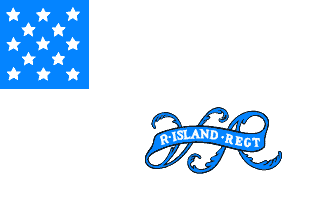
1st Rhode Island Regiment
|
The Rhode Island Regiment Colors 1781
The 1st Rhode Island Regiment was a Continental Army regiment from Rhode Island during the American Revolutionary War (1781–1783). Like most regiments of the Continental Army, the unit went through several incarnations and name changes.
It became well-known as the "Black Regiment" because, for a time, it had several companies of African American soldiers. Although it is regarded as the first African-American military regiment, its ranks were not exclusively African-American.
|
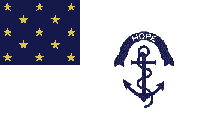
2nd Rhode Island Regiment
|
The Rhode Island Hope Regiment Colors 1781
Although tradition claims that the Rhode Islanders were among the first to join the Minutemen outside of Boston, and the Rhode Island regiments served at the Battles of Brandywine Creek and Trenton, the regiments were not formed until 1781. They most certainly were at Yorktown and remained active until the end of the Revolution. The starry canton in the flag of the Rhode Island Regiment symbolized national unity, but the white field corresponded to the uniforms of the Rhode Island troops. The anchor symbol and motto which completed the design had been used as a government symbol since 1647 and is carried in the current state flag.
This flag is preserved today in the State House at Providence, Rhode Island. |
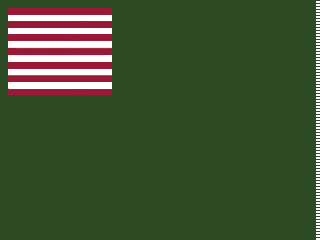
The Dansey Flag

The Dansey Flag
(variant version)
|
Delaware Militia Colors 1776
The Battle of Brooklyn Heights, part of the longer Long Island campaign of the Summer of 1776, was the first battle of George Washington's new Continental Army, just a month after it was formed. It began a series of defeats for the untried rebel forces at the hands of British General Howe's experienced combat forces that eventually ended with Washington's famed night-time retreat across the East River on the night of August 29, 1776, into the forest of New Jersey and Pennsylvania. According to tradition, the dogged rear guard actions of the Delaware Militia, with flag flying, and the 1st Maryland Regiment, prevented the capture of the majority of Washington's army during the Colonial withdrawal.
The Delaware Militia flag appears in the modern painting of the "Battle of Long Island" by Domenick D'Andrea (2007). It is based on the Dansey Flag, named for British Captain William Dansey, who it is claimed captured it from the Delaware Militia at the Battle of the Brandywine, not Brooklyn Heights. Dansey supposably took the flag home to England as a war trophy, where it stayed until 1927, when the Historical Society of Delaware bought it.
The flag still exist in the collection of the Delaware Historical Society, but the green color is so faded, it is hard to determine the shade of the original green. The flag has a matching green colored fringe on the fly end. |
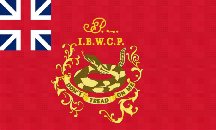
1st Battalion Standard

Obverse side
|
Colors of the First Battalion Westmoreland County Volunteers 1775
This was the Rattlesnake Flag of Colonel John Proctor's 1st Battalion from Westmoreland County, Pennsylvania. Westmoreland County was the farthest western part of Pennsylvania during the American Revolution. Formed in May of 1775, the First Battalion was comprised of volunteers and except for few months with Washington's army in 1777, the Battalion was used defending Western Pennsylvania against British-inspired Indian raids. Their arms were mostly privately owned, and their clothing was typical of civilians on the frontier. Apparently only the officers could afford or wore uniforms.
According to tradition this flag was made in 1775 at Hanna's Town from a pre-existing British standard. The initials "J.P." and "I.B.W.C.P." stand for Colonel John Proctor's "Independent Battalion, Westmoreland County, Pennsylvania." The retention of the British symbol on the flag suggests that the inhabitants of Westmoreland County, although ready to resist the British Parliament, still considered themselves loyal subjects of King George III in 1775.
This flag was designated the official flag of Westmoreland County in 1973, the county's bicentennial year, and today the original resides in the William Penn Memorial Museum.
|
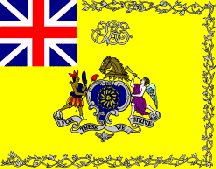
Original 1774 Version
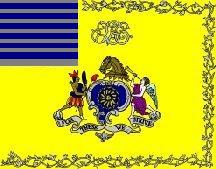
Philadelphia Light Horse
1775 version
|
Colors of the Philadelphia City Light Horse Troop 1774
In September of 1747, as the first Continental Congress met at Philadelphia, large amounts of British troops arrived in America to put down colonial unrest, seize and secure the military stores, and erect fortifications. In this alarming crisis, this troop was formed by a group of Philadelphia "gentlemen." Many were businessmen and merchants who supplied their own uniforms, military equipment and horses.
The flag was contributed to the unit by Captain Markoe. It was designed by John Folwell and hand-painted by James Claypoole. According to legend, the British Union had been originally painted in the canton, but the artist was instructed to paint thirteen blue and silver stripes over it to represent the united colonies.
It was this troop of men that escorted General Washington from Philadelphia to first take command of the Continental Army which was assembled at Cambridge outside of Boston in June of 1775. Throughout 1776 and 1777, while General Washington was in New Jersey and Pennsylvania, many times the Troop acted as his body guard.
The Light Horse Troop later carried their flag in the Battles of Brandywine Creek, Germantown, Princeton, Trenton, and then served throughout the whole war. They also went on to served with distinction in the War of 1812. |
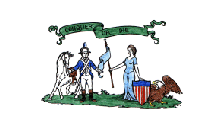
Washington's Life Guards
|
Colors of the Commander-in-Chief Guards 1776
In 1776, General Washington had four soldiers hand-picked from each regiment of the Continental Line to form the "Commander-in-Chief's Guards" or "Life Guards." The Guards were under the command of Major Caleb Gibbs. The Guards not only protected General Washington, but were at times involved in military operations. They served General Washington until the unit was disbanded shortly after Yorktown.
There were also traitors in the Guards. Sergeant Hickey and a few others were involved in a plot to kidnap or assassinate General Washington. Hickey was tried and hung, but there are no records of what happened to the other members of the Guards who were accused.
This regimental flag is one of several historical flags on display at the George Washington Masonic Memorial and Museum in Alexandra, Virginia.
|
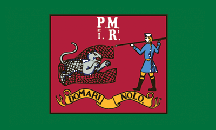
1st Pennsylvania Rifles
|
Colors of the First Pennsylvania Rifles 1775
This is the flag of the First Pennsylvania Rifles. The regiment would see action during the New York Campaign, Battle of Trenton, Second Battle of Trenton, Battle of Princeton, Battle of Brandywine, Battle of Germantown, Battle of Monmouth and the Battle of Springfield. The letters "P.M." on the flag refers to "Pennsylvania Militia," and the "i.R." is "1st Rifles." The Latin legend "Dominari Nolo" means "I Will Not Be Dominated" and refers to the American's desire to be free from the King of England.
|
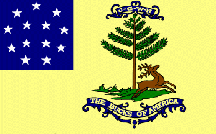
Bucks of Massachusetts Flag
|
The Colors of the Bucks of Massachusetts
This regiment of volunteer freemen was the only documented black military unit of the Revolutionary War. Massachusetts Governor John Hancock presented these regimental colors to the unit after the war was over. The initials above the pine tree (JGWH) are those of his son, John George Washington Hancock, who died in the war. The original flag is on display in Boston at the Massachusetts Historical Society. |
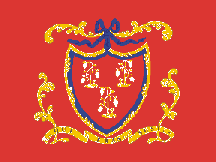
2nd Connecticut Regiment
|
Colors of the Second Connecticut Regiment 1776
The 2nd Connecticut Regiment was formed in 1776 as part of the Continental Army. Eight companies were recruited from the counties of Fairfield, Windham, and Hartford and assigned to the 1st Connecticut Brigade. The regiment would see action in the New York Campaign, Battle of Brandywine, Battle of Germantown and the Battle of Monmouth. The three grape vines on the "Arms of Connecticut" shield, represent the three original settlements of the colony; Hartford, Windsor, and Wethersfield. The motto is "Qui Transtulit Sustinet," and means "He who brought us here will take care of us."
|
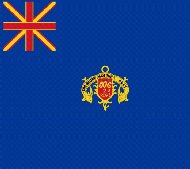
2nd New Hampshire Blue Standard
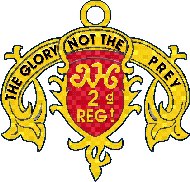
2nd New Hampshire Blue Arms
Closeup
|
Colors of the 2nd New Hampshire
The 2nd was one of two New Hampshire regiments that reported to Washington's camp in Cambridge at the beginning of the Revolutionary War in 1776. Henry Dearborn led the men from New Hampshire and troops under John Sullivan held the "rail fence" on one of the flanks at the Battle of Bunker Hill. In the spring of 1776, the Second saw action at Fort Ticonderoga, Mount Independence, Bennington, and wintered at Valley Forge. Men from New Hampshire would take part in nearly every battle fought in New England, including the turning point of the American Revolution at Saratoga.
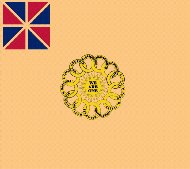 |
|
 |
2nd New Hampshire Buff Standard
(possibly the 11th Massachusetts instead) |
|
2nd New Hampshire Buff Arms
Closeup |
The 2nd New Hampshire's first leader was Colonel Enoch Poor, but by the time of the Battle of Hubbardstown (Hubbardton), where these two flags may have been captured by the British 9th Foot, it was commanded by Colonel Nathan Hale. The British dispatches of the day suggest that the flags were taken at Fort Anne (or at Hubbardstown, on the previous day), quite some distance from the battle, and probably the supply base of the Americans. |
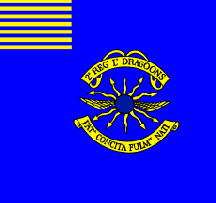
Continental Light Dragoons
|
Colors of the 2nd Regiment of the Continental Light Dragoons 1775
The 2nd Continental Light Dragoons, also known as "Sheldon's Horse," named after their commander Colonel Elisha Sheldon, was the first of four Dragoon regiments to be raised during the War and the only Dragoon regiment to serve throughout the War. Appointed Colonel Commandant by order of General Washington in December of 1776, Sheldon served as commander of the Second Dragoons until the end of the American Revolution. Under his command, the regiment would see action at the Battle of Brandywine, Battle of Saratoga, Battle of Germantown, Battle of Crooked Billet and the Battle of Yorktown.
In this era of slow moving armies with rigid, massed battle formations, Dragoons were unique. Often described as mounted infantry, a combined troop of mounted and dismounted Dragoons could speedily sweep into an enemy's flanks, then under the cover fire from the dismounted Dragoons, the mounted Dragoons would assault the enemy with rapid saber charges, then retreat and reform before the enemy could react.
This mobility also made them excellent for information gathering. The Light Dragoons have been called "Washington´s Eyes," and were reportedly used by Major Benjamin Tallmadge, Washington's "Spy Master", for that purpose. |
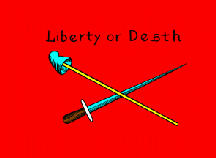
White Plains Flag
|
The White Plains Flag 1776
This White Plains Flag, emblazoned with the Liberty cap and staff as well as the sword of Justice, was captured from a New York militia unit in the fall of 1776 by German mercenaries fighting for the English. Although the Germans belittled the American military skills, it is interesting to note that these very same Hessians were forced to surrender to General Washington at the Battles of Princeton and Trenton several months later.
The Liberty Cap was a tight-fitting hat that became a popular symbol for the fight for independence and freedom. It would often be carried on a staff during a parade or rally, and later became a common feature on early American coins.
|
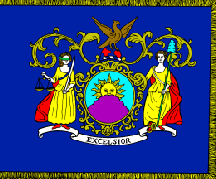
3rd New York Regiment
|
Colors of the Third New York Regiment 1775
The 3rd New York Regiment was formed in 1775 from volunteers from the counties of Ulster, Dutchess, Orange, and Suffolk under the command of Colonel James Clinton for service in Canada. The regiment would take part in the Invasion of Canada, and later under the command of Colonel Peter Gansevoort it took part in the defeat of General Burgoyne in upper New York State in 1777. The regiment was merged into the 1st New York Regiment in 1781. The flag has been saved and is found in the Albany Institute of History and Art. It is the only regimental flag of New York that has been preserved to the present.
|
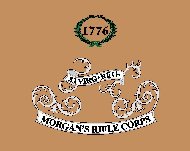
Morgan Rifle Corps Standard
|
Colors of Morgan's Rifle Corps 1776
Daniel Morgan was a first cousin of Daniel Boone. Under his leadership, Morgan's Rifle Corps played a key role in the Battle of Saratoga. In that battle, the riflemen were used to initiate fires on the American side, targeting key personnel such as officers and artillerymen.
In 1777, Morgan formed and commanded the 11th Virginia Regiment (see below) and in October of 1780 Morgan was given the rank of Brigadier General. His elite corps of riflemen became part of the 11th Virginia and their efforts led to victory at the Battle of Cowpens, considered the turning point of the Revolution in the south, in January of 1781. |

11th Virginia Regiment
|
Colors of the Eleventh Virginia Regiment 1777
In 1777 Colonel Daniel Morgan was assigned to raise and command a new regiment, the 11th Virginia Regiment of the Continental Line. His recruiting test for riflemen became campfire legend. He printed a picture of the head of a British officer (some said King George himself) and only recruited those who could hit this target with their first shot at one hundred yards. When word of this reached England Morgan was regarded as a war criminal.
The 11th Virginia Regiment saw action at the Battle of Brandywine, Battle of Germantown, Battle of Monmouth, and the Battle of Cowpens, to name a few. Considered one of the most gifted battlefield tacticians of the American Revolution, Morgan later commanded the troops that suppressed the Whiskey Rebellion and was elected to Congress in 1797.
|
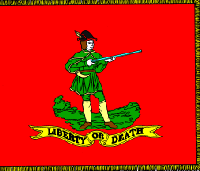
Hanover Associators
|
Colors of the Hanover Associators 1774
The Hanover Association of Volunteers was formed in June 1774, in Lancaster County, Pennsylvania. They resolved "that in the event of Great Britain attempting to force unjust laws upon us by strength of arms, our cause we leave to Heaven and our rifles." The colors are described as "Red field and trim on cap; yellow fringe and scroll; black lettering and cap; green ground and uniform with cream legs, trim, feather and powder horn; brown belt and light blue rifle barrel." This flag no longer exists, but the design shown here is based on an engraving in the Pennsylvania State Archives.
|
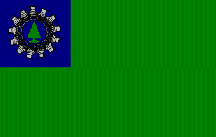
Newburyport Company
|
Colors of the Independent Company of Newburyport 1775
Newburyport is a small coastal city in Massachusetts, 38 miles northeast of Boston. Right from the beginning of the Revolutionary War, Newburyport was involved. Matthew Thornton, a Newburyport resident, was a signer of the Declaration of Independence. Paul Revere cast the clock tower bell of the First Presbyterian Church of Newburyport and it was not surprising that the residents of this town would have a militia unit involved in the war. The main responsibility of the Independent Company of Newburyport seems to have been protecting the Massachusetts coastline from British intrusion. Their colors have been described as a "Green field and tree, blue canton, silver mailed hands and chain." |
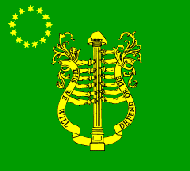
The Headman Flag
|
The Headman Flag
This flag of an unknown Revolutionary War Regiment is located in the Smithsonian Museum and described as "The Headman Flag," because it was preserved by the Pennsylvania family descended from a Sergeant Headman. The inscription on the scroll reads "THIS WE WILL DEFEND OR DIE," and the word "LIBERTY" is written on the cap. The flag portrays thirteen arms grasping a column topped with a liberty cap, symbolizing the thirteen colonies united in their fight for freedom.
There are many theories about this flag fragment, one of which is that the well-known flag of the Green Mountain Boys was not theirs, but a missing piece of this flag. The Bennington Museum has the remaining piece of the "Green Mountain Boys" flag, and another piece of green silk supposedly from the flag that has some fancy filigree painted on it which seems to match the painted borders on the Headman Color. |

Newport Light Infantry
|
Colors of the Newport Light Infantry 1775
The Newport Light Infantry Brigade was one of two brigades that formed the New Hampshire militia whose main role was to protect the coast from attack by the Royal Navy and to support the other New England states. The second brigade was organized in the west to guard the frontier against attack from Canada. John Langdon, who after the Revolutionary War would go on to represent New Hampshire at the Constitutional Convention, took command of one of the units in General William Whipple's eastern brigade. Langdon's Newport Light Infantry, often called the "Silk-Stockings" by his contemporaries because it was composed of wealthy citizens who all had held officer commissions in their own local militia units, was in fact a highly trained and effective combat organization.
|
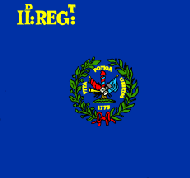
South Carolina 2nd Regiment
|
Colors of the South Carolina 2nd Regiment
The Flag of the Second South Carolina Regiment featured the motto ""VITA POTIOR LIBERTAS" which meant "Liberty rather than life." Colonel William Moultrie's South Carolina Militia of Ft. Sullivan fame (see Fort Moultrie Flag) first carried this regiment standard, and later the famous "Swamp Fox" Francis Marion carried it at the Battle of Savannah. Sergeant Jasper, who had saved the Crescent Flag at Sullivan's Island, fell carrying this at Savannah. The colors are described as "Blue field, yellow letters, green wreath, red ribbon, red and blue flags within."
|
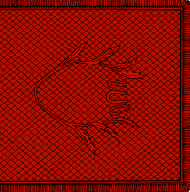
Colonel William Washington's Cavalry Standard
|
Colors of the Third Regiment of Continental Light Dragoons
The romantic story behind this regimental flag is that Jane Elliott, Colonel William Washington's Fiancé made it for him before he left on his campaign through Eutaw and the Cowpens. (Colonel Washington was George's brother.)
According to the legend, when she had asked him to bring back his standard covered in glory, he confessed he had no standard. She immediately cut a square of crimson brocade from her living room curtain and hastily made him a flag. He indeed covered it in glory, and according to the legend they later flew it at their wedding.
|
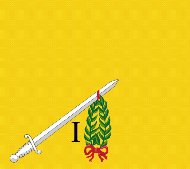
9th Connecticut Regiment Standard
|
Flag of Webb's Continental Regiment, Continental Line
This guidon belonged to the First Company of the Continental Regiment of Foot, formed by Washington in 1777 under the command of Colonel Samuel Blatchley Webb of Connecticut. Webb had formerly served as one of Washington’s personal aides.
The Connecticut Line was a formation within the Continental Army. The term "Connecticut Line" referred to the quota of numbered infantry regiments assigned to Connecticut at various times by the Continental Congress. These, together with similar contingents from the other twelve states, formed the Continental Line. Webb’s Regiment was officially designated the 9th Connecticut Regiment and would first see action at the Battle of Rhode Island. The regiment was consolidated into the 2nd Connecticut Regiment in 1781 and disbanded in 1783.
|

Sheldon's Horse Standard
|
Colors of the 2nd Regiment Continental Light Dragoons
The 2nd Continental Light Dragoons, also known as Sheldon's Horse, was commissioned by the Continental Congress in December of 1776 under the command of Colonel Elisha Sheldon. From March 1777 until January 1781 the regiment consisted of six troops drawn mostly from Connecticut, but with men from Massachusetts , New Jersey, and New York. Although parts of the regiment would see action at the Battle of Brandywine, Battle of Saratoga, Battle of Germantown, and the Battle of Yorktown, the unit never served as a whole, rather the unit was assigned by Washington in various support and special assignments. For example,
at the Battle of Saratoga a portion of the regiment not only fought as the sole Continental cavalry, but was assigned to escort Burgoyne to Boston after the British surrender. Elements of the unit comprised Washington's personal bodyguard, and Sheldon's Horse performed the first cavalry charge on American soil. The regiment also provided messengers for Washington between his headquarters and the rest of the colonial forces. At Yorktown, twenty Sheldon's Horse were detailed to accompany Washington and Rochambeau to the York peninsula, and Sheldon's troopers are depicted in the painting of Cornwallis' surrender by John Trumbull.
These colors were taken by British forces under Banastre Tarleton at the Battle of Pound Ridge, New York in July 1779. In June of 2006, the flag was returned and auctioned at Sotheby's in New York City.
|
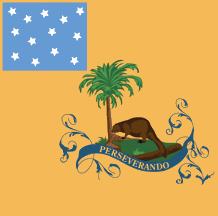
Third Virginia Standard
|
Colors of the Third Virginia Regiment 1775
The 3rd Virginia Regiment was formed in 1775 in Alexandria, Virginia, and its notable commanders included Colonel Hugh Mercer, Colonel George Weedon, Colonel Thomas Marshall (the father of Supreme Court Chief Justice John Marshall), Colonel William Heth, and finally Colonel Abraham Buford. James Monroe, Thomas Helm, and John Marshall served as lieutenants in this regiment.
The regiment saw action in the New York Campaign, Trenton, Princeton, Brandywine, Germantown, Valley Forge, Monmouth and the Siege of Charleston. In 1780, when the 3rd Virginia under the command of Colonel Buford was trapped by a British and American Loyalist force under Colonel Banastre Tarleton, the American forces suffered over a hundred casualties (many of whom were sabred to death as they attempted to surrender) in what became known as the Waxhaw Massacre. During the confusion the 3rd Virginia colors were one of four captured by the British. In 2006, the four regimental flags taken at the massacre sold at Sotheby's auction for over $5,000,000.
These regimental colors are one of the earliest surviving American flags bearing 13 stars. It also had a painted beaver on it that was copied from the engraving used on the $6 Continental bill. The Latin motto Perseverando (to persist) was also included as part of the design.
|
| Top of Page | Flags before 1776 | Flags after 1776 | Unit Standards and Colors | War of 1812 |
|